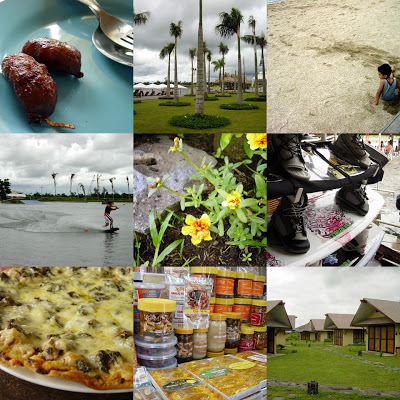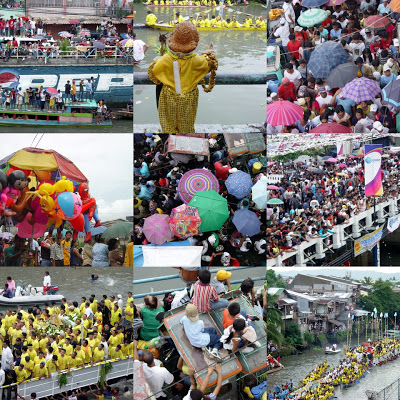
Whew! What a weekend! Since we flew out in the wee hours of Saturday morning until we left Bicol yesterday (again in the wee hours), it was non-stop activities. K writes freelance for the in-flight magazine of our national carrier so we were toured around by the friendly folk of the Department of Tourism there.
Bicol is one of the 16 regions in the Philippines and is on the Southeastern tip of Luzon (Luzon is one of our 3 island groups. Manila, where I live, is also in Luzon. The other 2 island groups are the Visayas, where Boracay and Cebu are, and Mindanao, where Zamboanga is. Just to give you a little orientation…).
First stop – Camarines Sur, one of the 6 provinces in Bicol, to see the Camsur Watersports Complex (located in Pili) and its much-lauded cable park (built by their young and spirited governor, who also happens to be a wakeborader). Wakeboarders from all over have already flocked here to board in what is arguably the best cable park in the world (with the cheapest rates!). If you are a wakeboarder (or water-skier or wakeskater) this is definitely a place to visit. C used to wakeboard but I, regrettably, could not master a water sport (ok fine, any sport) to save my tush. So I just had their laing pizza which was absolutely delicious and made me forget all about my woe at not being a Billabong-babe!
Laing is a typical Bicolano dish make with dried gabi leaves (taro leaves) stewed in coconut milk (another very typical ingredient in Bicolano cuisine), and because it’s Bicol – home of the spiciest cuisine in our country – a bunch of chilies. The laing pizza is loaded with laing, then sprinkled with Bicol Express (another regional dish…more about this later), and topped with mozzarella cheese. This may sound beyond bizarre to some of you but it was GOOD. Just think of it as a, um, spicy spinach pizza.

After the laid-back, “life’s-a-beach”, vibe at the cable park, we headed to Naga City proper to witness the grand fluvial procession of the Peñafrancia Festival. No two activities could be more different. When we reached Naga things were already reaching a fever pitch. Devotees were flocking to the Naga Cathedral, and to every open space by the river, to watch Our Lady of Peñafrancia pass by en route to the Basilica Minore. Referred to by Bicolanos as Ina (mother), they come from all over (even out of the country!) to see her. A legion of long boats line up on the river to pull her barge. We were able to get a prime spot on a third floor balcony to watch. We stood there for 3 solid hours waiting, not daring to move lest we lose our precious vantage point. The soles of my feet were crying out in protest but still I held fast. The people below us by river had been standing there for much, much longer. Finally, we heard a series of kwitis (some kind of firework) sound off, signaling her arrival on the pagoda that would take her down the river towards us. The excitement in the crowds was palpable as we craned our necks to see, even though we all knew she was still too far away. At last the barge that carried her came into view, filled to the brim with people and devoted followers hanging off the sides. Everywhere you could see, people were enthusiastically waving white handkerchiefs and shouting “Viva la Virgen!”. Suddenly the soreness left my feet and the tiredness left my body. And to be totally honest, I felt the prickle of tears behind my eyes. It is one thing to have faith, and it is quite another to see it physically manifested in such magnitude, sweeping you up in a wave of emotion you have neither the wisdom nor experience to understand. To say I was moved would be an understatement.
Tired yet exhilarated, we made it back to our hotel (charmingly called Pepperland – we were in the region of chili peppers after all) at the end of the day, where the luxury of a hot shower, and an even hotter dinner, awaited us. We decided to have laing and Bicol Express – two dishes which seem to embody Bicolano cuisine. Laing I have already mentioned above. Bicol Express is a dish of pork and chilis (lots of them) stewed in coconut milk. What gives Bicol Express its distinct flavor (aside from the chilis) is balao, a shrimp fry mix similar to bagoong but with slightly bigger fry and less salty. Now, there is much debate over the origins of the dish and its name, but I will not get into that here. Suffice to say that we loved it and had it with every meal (except breakfast) and never grew tired of it. Personally, it would be very hard for me not to love Bicol Express as I already love its basic components – pork, chili, and coconut milk. Again, chili and coconut milk (coconut being a huge industry in the region) make their presence felt throughout Bicolano cuisine…and I am only too happy to partake.
Leave a Reply